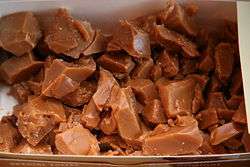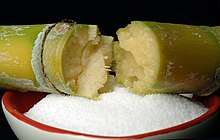Toffee
Toffee is a confection made by caramelizing sugar or molasses (creating inverted sugar) along with butter, and occasionally flour. The mixture is heated until its temperature reaches the hard crack stage of 149 to 154 °C (300 to 310 °F). While being prepared, toffee is sometimes mixed with nuts or raisins.
 | |
| Type | Confectionery |
|---|---|
| Course | Dessert |
| Main ingredients | Sugar or molasses, butter |
| Variations | English toffee, honeycomb toffee |
Creation
The process of making toffee requires the boiling of ingredients until the mix is stiff enough to be pulled into a shape that holds and has a glossy surface. The resulting mixture will typically be poured into a shallow tray and allowed to cool to form a slab. Different mixes, processes, and most importantly, temperatures, will result in different textures and hardnesses, from soft and often sticky to a hard, brittle material. A brown color, and smoky taste, is imparted to the toffee by the caramelization of the sugars.
Variants and applications
A popular variant in the US is English toffee, which is a very buttery toffee often made with almonds. It is available in both chewy and hard versions. Heath bars are a brand of confection made with an English toffee core. Although named English toffee it bears little resemblance to the wide range of confectionery known as toffee currently available in the United Kingdom. However, one can still find this product in the UK under the name "butter crunch." Conversely, in Italy they are known as "mou candies".[1]
Another variant is honeycomb toffee, which is an aerated version with bubbles introduced by adding baking soda and vinegar while mixing. These react to form carbon dioxide, which is trapped in the highly viscous mixture. In the UK and Canada, the best known honeycomb confection is the Crunchie bar. A similar Australian chocolate bar is the Violet Crumble. In New Zealand, vanilla ice cream with pieces of honeycomb in it is called hokey pokey.
A particular application of toffee is in toffee apples, sometimes called candy apples, which are apples coated with hard toffee mounted on sticks. Toffee apples are similar to taffy apples and caramel apples, which are both covered in caramel.
Toffee used in confectionery can be mixed with many different ingredients to produce a variety of flavors: rum and butter, chocolate covered, vanilla and chocolate, rum and raisin, raspberry, and honeycomb.
Etymology
The origins of the word are unknown. Food writer Harold McGee claims it to be "from the Creole for a mixture of sugar and molasses", but which creole language is not specified.[2] The Oxford English Dictionary dates the first publication of the word to 1825 and identifies it as a variation of taffy (1817), both of which are first recorded as English dialectical words.[3][4]
See also
| Look up toffee in Wiktionary, the free dictionary. |
| Wikimedia Commons has media related to Toffee. |
References
- Hughes, Glyn Lloyd (2010). The Foods of England. Tomato. p. 265. ISBN 9780955694837.
- McGee, Harold (2004). On Food and Cooking: The Science and Lore of the Kitchen. Scribner. p. 650. ISBN 9780684800011.
- "toffee, n. and a.", Oxford English Dictionary Second Edition 1989
- "taffy1", Oxford English Dictionary Second Edition 1989
